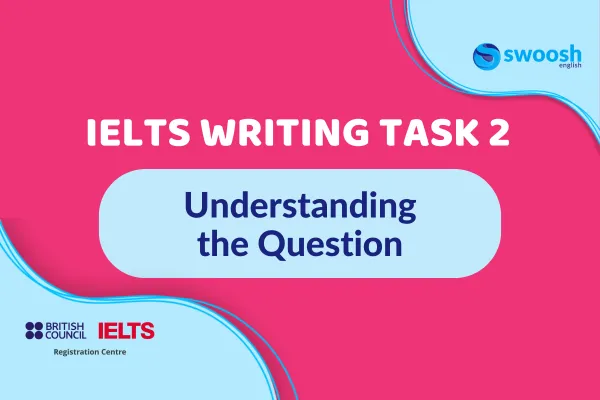Blog
Browse our library of helpful articles

IELTS Writing Task 2: Understanding the Question
When it comes to acing IELTS Writing Task 2, the first step is to fully grasp and interpret the question. By honing your skills in comprehending the question, you'll be better equipped to craft well-structured and relevant responses, ultimately boosting your chances of success in the exam. In this article, we’ll delve into the essential strategies for decoding and mastering the IELTS Writing Task 2 questions.
The typical instructions in Writing Task 2 include:
To what extent do you agree or disagree with this opinion?
Discuss both these views and provide your own opinion.
Do you think the advantages of... outweigh the disadvantages?
Has this become a positive or negative development? (less common)
All these questions prompt you to evaluate views and opinions regarding a common situation or problem. The issues are usually familiar, requiring no specialised knowledge from you.
Common topics include education, health and fitness, childcare, languages, technology, the environment, and globalisation.
Another common type of IELTS Task 2 question presents a problem that you must propose solutions for. For instance:
"In some countries, the average weight of people is increasing while their levels of health and fitness are decreasing. What do you think are the causes of these problems and what measures could be taken to solve them?"
Here, you're expected to identify reasons for weight gain and suggest potential solutions.
Occasionally, you might encounter more specific questions, such as:
What factors contribute to job satisfaction?
What, in your opinion, should be the primary function of a university?
It is evident that reading the question carefully is of utmost importance. The time invested in this step is invaluable, and rushing through it can cause you to overlook crucial aspects of the question.
Here is an example of a question where students often make mistakes:
"In recent times, the manner in which people interact has been transformed due to technological advancements. How has technology influenced the nature of relationships individuals form? Is this shift considered positive or negative? Justify your stance with explanations and incorporate pertinent examples from your own knowledge or experience. Write at least 250 words."
Students frequently approach this question by discussing general advantages and disadvantages, such as technology making life easier or causing health issues. However, the question specifically focuses on "how people interact" and "the types of relationships formed." Therefore, it's essential to provide examples and reasons for the changes in relationships brought about by technology, including those at work, within families, and in social settings.
A helpful strategy to ensure you address the question effectively is to break it down into parts:
Topic
Focus
Instruction
In the given question, the topic is the impact of technology, while the focus is on changes in relationships. Your introduction should begin with a sentence related to the topic, including some general background information. The focus should be the main aspect developed in your writing.
The instruction requires you to provide reasons and examples supporting your viewpoint and write a minimum of 250 words. Failure to meet this word count may indicate an incomplete response and inadequate essay development.
Remember that your work is evaluated based on four marking criteria for Writing Task 2:
Task Achievement: Address all aspects of the task.
Coherence and Cohesion: Organise your writing with paragraphs and linking words.
Lexical Resource: Utilise a wide range of formal vocabulary.
Grammatical Range and Accuracy: Demonstrate control over language use.
During your preparation, make sure you are familiar with the marking criteria and understand exactly what the examiner will be looking for.
In conclusion, if your writing exhibits weaknesses in areas like grammar, you can compensate by thoroughly focusing on the question and developing a strong argument based on this focus, ensuring you fully accomplish the task. Conversely, excellent language skills alone may not suffice if you fail to address the question adequately. Therefore, it is crucial to invest a few minutes in carefully reading the question, understanding the topic, and focusing before starting to write or create a plan.
Good luck with your IELTS Writing preparation and add your questions to the comments below.

IELTS Writing Task 2: Understanding the Question
When it comes to acing IELTS Writing Task 2, the first step is to fully grasp and interpret the question. By honing your skills in comprehending the question, you'll be better equipped to craft well-structured and relevant responses, ultimately boosting your chances of success in the exam. In this article, we’ll delve into the essential strategies for decoding and mastering the IELTS Writing Task 2 questions.
The typical instructions in Writing Task 2 include:
To what extent do you agree or disagree with this opinion?
Discuss both these views and provide your own opinion.
Do you think the advantages of... outweigh the disadvantages?
Has this become a positive or negative development? (less common)
All these questions prompt you to evaluate views and opinions regarding a common situation or problem. The issues are usually familiar, requiring no specialised knowledge from you.
Common topics include education, health and fitness, childcare, languages, technology, the environment, and globalisation.
Another common type of IELTS Task 2 question presents a problem that you must propose solutions for. For instance:
"In some countries, the average weight of people is increasing while their levels of health and fitness are decreasing. What do you think are the causes of these problems and what measures could be taken to solve them?"
Here, you're expected to identify reasons for weight gain and suggest potential solutions.
Occasionally, you might encounter more specific questions, such as:
What factors contribute to job satisfaction?
What, in your opinion, should be the primary function of a university?
It is evident that reading the question carefully is of utmost importance. The time invested in this step is invaluable, and rushing through it can cause you to overlook crucial aspects of the question.
Here is an example of a question where students often make mistakes:
"In recent times, the manner in which people interact has been transformed due to technological advancements. How has technology influenced the nature of relationships individuals form? Is this shift considered positive or negative? Justify your stance with explanations and incorporate pertinent examples from your own knowledge or experience. Write at least 250 words."
Students frequently approach this question by discussing general advantages and disadvantages, such as technology making life easier or causing health issues. However, the question specifically focuses on "how people interact" and "the types of relationships formed." Therefore, it's essential to provide examples and reasons for the changes in relationships brought about by technology, including those at work, within families, and in social settings.
A helpful strategy to ensure you address the question effectively is to break it down into parts:
Topic
Focus
Instruction
In the given question, the topic is the impact of technology, while the focus is on changes in relationships. Your introduction should begin with a sentence related to the topic, including some general background information. The focus should be the main aspect developed in your writing.
The instruction requires you to provide reasons and examples supporting your viewpoint and write a minimum of 250 words. Failure to meet this word count may indicate an incomplete response and inadequate essay development.
Remember that your work is evaluated based on four marking criteria for Writing Task 2:
Task Achievement: Address all aspects of the task.
Coherence and Cohesion: Organise your writing with paragraphs and linking words.
Lexical Resource: Utilise a wide range of formal vocabulary.
Grammatical Range and Accuracy: Demonstrate control over language use.
During your preparation, make sure you are familiar with the marking criteria and understand exactly what the examiner will be looking for.
In conclusion, if your writing exhibits weaknesses in areas like grammar, you can compensate by thoroughly focusing on the question and developing a strong argument based on this focus, ensuring you fully accomplish the task. Conversely, excellent language skills alone may not suffice if you fail to address the question adequately. Therefore, it is crucial to invest a few minutes in carefully reading the question, understanding the topic, and focusing before starting to write or create a plan.
Good luck with your IELTS Writing preparation and add your questions to the comments below.
© 2023 - All Rights Reserved

